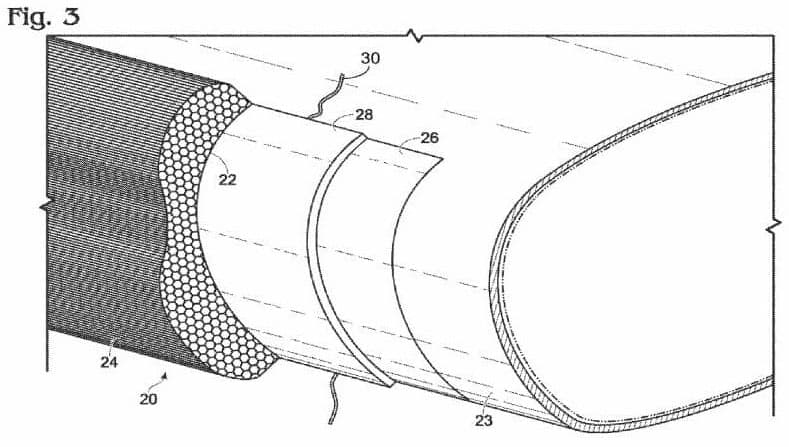Ice, Ice, Boeing

Boeing’s patent filed with the US Patent Office displaying faux ice buildup on a plane’s wing. Courtesy of the US Patent Office.
Latest News
April 21, 2016
For those of you out there that didn’t get the headline, ice isn’t just for drinks or making white rappers famous. Introduced to airplane wings, ice ranks as a danger right up there with anti-aircraft fire, running into drones or having a kid in a 14th floor suite shine a laser in the pilot’s eyes as he’s trying to land. As ice builds up on a wing, it changes the aerodynamics, putting more stress on the systems and increasing the chances of a crash.
Obviously planes can’t be grounded every time a pilot spots a snowflake, so regulatory bodies around the world require that planes be designed and certified to continue operations in inclement conditions. Because engineers of every stripe realize that computer simulations must be verified, actual aircraft testing is conducted in supercooled wind tunnels, where ice is allowed to build up on the wings.
 Boeing’s patent filed with the US Patent Office displaying faux ice buildup on a plane’s wing. Courtesy of the US Patent Office.
Boeing’s patent filed with the US Patent Office displaying faux ice buildup on a plane’s wing. Courtesy of the US Patent Office.Technicians then make faux ice masses based on the buildup from glassfiber and resin and bolt them onto a plane’s wings. Pilots then must demonstrate the plane is still flight-worthy for an aircraft to receive its certifications.
Boeing isn’t enamored of the process, complaining it takes too long and is too expensive. Rather than just complain, however, the company turned its creative minds toward a practical solution. The end result was using 3D printing to build mock ice masses that simulate the qualities of ice buildup on wings, without actually requiring the ice.
Icy masses are designed in CAD before being printed out in whatever material seems most appropriate. As a result of 3D printing the masses, the masses fit snugly on a wing and can be held in place with adhesive rather than bolts. This reduces the chances of causing damage to the expensive machines.
Rather than a single type of test mass, 3D printed masses can be built in a variety of shapes, with different textures and densities. The result is better simulated ice, according to Boeing. Each fake chunk of ice can even be printed to include labels and identification markers to ensure they are properly placed.
For now, the idea sits at the patent office, but it may not be too long before your safety is the result of 3D printing. Below you’ll find a short video that explains the perils of ice buildup on aircraft wings.
Source: Gizmag, US Patent Office
Subscribe to our FREE magazine, FREE email newsletters or both!
Latest News
About the Author
John NewmanJohn Newman is a Digital Engineering contributor who focuses on 3D printing. Contact him via [email protected] and read his posts on Rapid Ready Technology.
Follow DE





